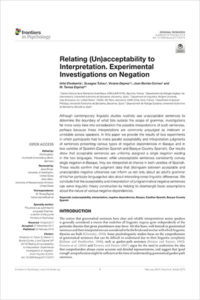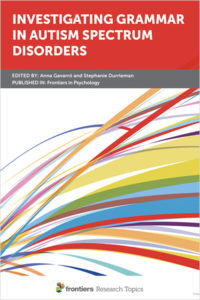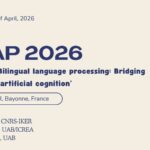4 abril, 2021
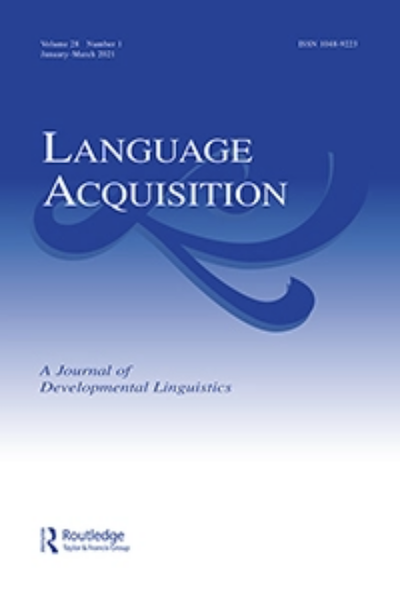
Autors:
Elena Pagliarini, Marta Andrada Reyes, Maria Teresa Guasti, Stephen Crain & Anna Gavarró
Títol:
Negative sentences with disjunction in child Catalan, Language Acquisition 2021Editorial: Routledge
Data de publicació: Gener del 2021
ISBN13: 1048-9223
Més informacióIn English, the sentence Mary didn’t eat pizza or sushi is assigned the neither interpretation (both disjuncts must be false). In Mandarin Chinese, the equivalent sentence is assigned the at least one interpretation (at least one disjunct must be false). The cross-linguistic variation in the interpretation of negative sentences with disjunction has been attributed to the Disjunction Parameter. On one value of this lexical parameter, disjunction is a Positive Polarity Item (+PPI). On the other value, disjunction is not a Positive Polarity Item (-PPI). According to the Semantic Subset Principle (SSP), all child language learners are predicted to initially assign the neither interpretation to negative disjunctive sentences, for reasons of language learnability. The present study investigates the interpretation of negative sentences with disjunction in Catalan. The findings confirm that disjunction is +PPI for adults; children show a bimodal distribution. For some children, disjunction is -PPI, as predicted by the SSP. However, some children adopt the adult +PPI value of the Disjunction Parameter. Children’s level of linguistic maturity, as measured by a sentence repetition task, was correlated with their judgments about negative sentences with disjunction such that children with lower scores tended to adopt the -PPI value. To explain the relatively early parameter resetting by some Catalan-speaking children, as compared to children acquiring other languages where disjunction is +PPI, we discuss the possible “blocking effect” of an alternative lexical expression in Catalan, which unambiguously conveys the neither interpretation.
3 març, 2021
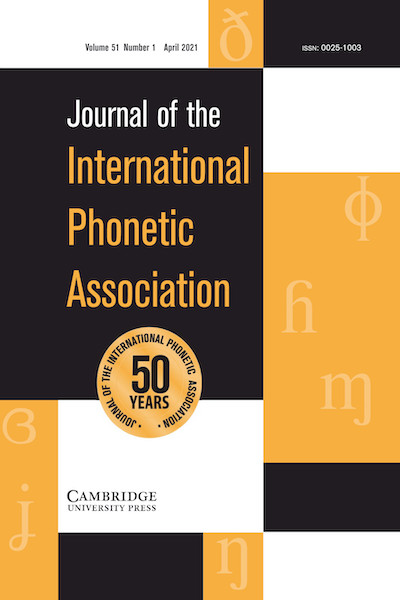
Autors:
Daniel Recasens
Títol:
Acoustic characteristics and placement within vowel space of full schwa in the world's languages: A surveyEditorial: Journal of the International Phonetic Association, Cambridge University Press
Data de publicació: 3 de març del 2021
Més informacióData from about one hundred languages reveal that, in spite of resulting typically from articulatory reduction of peripheral vowels in unstressed position, full schwa may also occur in stressed position in stress languages and in unreduced syllables in languages lacking stress. Formant frequency data reveal that this vowel is mid central, though somewhat shifted to the mid back unrounded area (particularly if long and placed in open syllables and at the edges of words), and exhibits a higher or lower realization depending on the number of mid vowels in the vowel system. In spite of occurring in stressed position, full schwa resembles unstressed schwa in being very short, highly variable and possibly low intensity, which accounts for why it is prone to occur in closed syllables and longer words, and may receive stress only if the remaining vowel nuclei in the word are central and/or short peripheral. Moreover, variability in the F1 and F2 dimensions increases with the number of peripheral mid vowels, which appears to obey symmetry and dispersion principles of vowel space organization.
13 abril, 2021
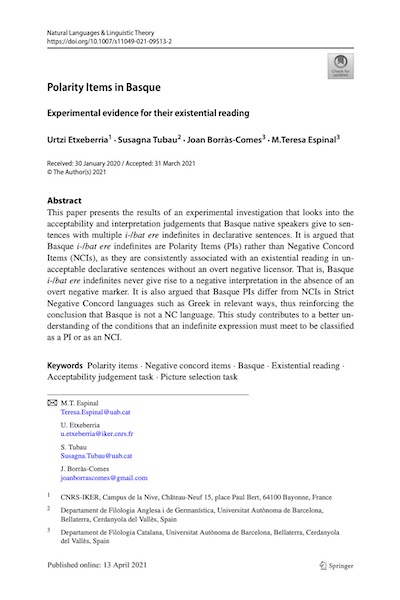
Autors:
Urtzi Etxeberria, Susagna Tubau, Joan Borràs-Comes & M.Teresa Espinal
Títol:
Polarity Items in BasqueEditorial: Natural Language & Linguistic Theory, Springer
Data de publicació: 13 d'abril del 2021
This paper presents the results of an experimental investigation that looks into the acceptability and interpretation judgements that Basque native speakers give to sentences with multiple i-/bat ere indefinites in declarative sentences. It is argued that Basque i-/bat ere indefinites are Polarity Items (PIs) rather than Negative Concord Items (NCIs), as they are consistently associated with an existential reading in unacceptable declarative sentences without an overt negative licensor. That is, Basque i-/bat ere indefinites never give rise to a negative interpretation in the absence of an overt negative marker. It is also argued that Basque PIs differ from NCIs in Strict Negative Concord languages such as Greek in relevant ways, thus reinforcing the conclusion that Basque is not a NC language. This study contributes to a better understanding of the conditions that an indefinite expression must meet to be classified as a PI or as an NCI.
14 juliol, 2021
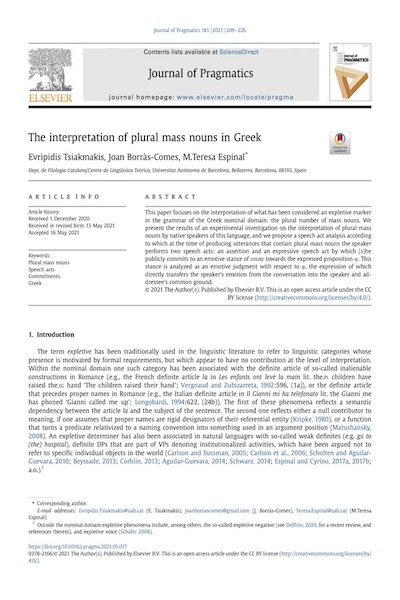
Autors:
Evripidis Tsiakmakis, Joan Borràs-Comes, M.Teresa Espinal
Títol:
The interpretation of plural mass nouns in Greek, Journal of Pragmatics 181Editorial: Elsevier
Data de publicació: Agost 2021
Més informacióThis paper focuses on the interpretation of what has been considered an expletive marker in the grammar of the Greek nominal domain: the plural number of mass nouns. We present the results of an experimental investigation on the interpretation of plural mass nouns by native speakers of this language, and we propose a speech act analysis according to which at the time of producing utterances that contain plural mass nouns the speaker performs two speech acts: an assertion and an expressive speech act by which (s)he publicly commits to an emotive stance of dislike towards the expressed proposition φ. This stance is analyzed as an emotive judgment with respect to φ, the expression of which directly transfers the speaker's emotion from the conversation into the speaker and addressee's common ground.
27 gener, 2022
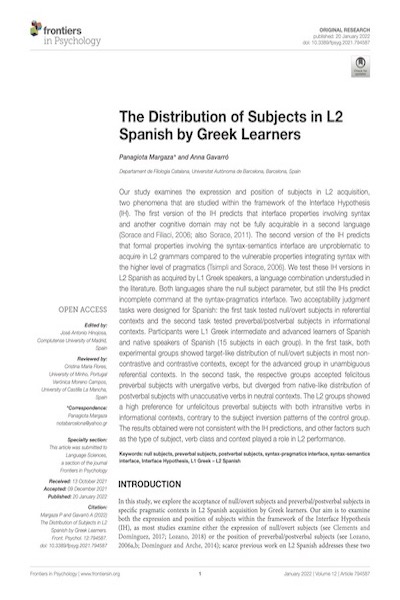
Autors:
Panagiota Margaza & Anna Gavarró
Títol:
The Distribution of Subjects in L2 Spanish by Greek LearnersEditorial: Frontiers in Psychology, Language Sciences
Col·lecció: Frontiers in PsychologyData de publicació: 20 gener 2022
Text completOur study examines the expression and position of subjects in L2 acquisition, two phenomena that are studied within the framework of the Interface Hypothesis (IH). The first version of the IH predicts that interface properties involving syntax and another cognitive domain may not be fully acquirable in a second language (Sorace and Filiaci, 2006; also Sorace, 2011). The second version of the IH predicts that formal properties involving the syntax-semantics interface are unproblematic to acquire in L2 grammars compared to the vulnerable properties integrating syntax with the higher level of pragmatics (Tsimpli and Sorace, 2006). We test these IH versions in L2 Spanish as acquired by L1 Greek speakers, a language combination understudied in the literature. Both languages share the null subject parameter, but still the IHs predict incomplete command at the syntax-pragmatics interface. Two acceptability judgment tasks were designed for Spanish: the first task tested null/overt subjects in referential contexts and the second task tested preverbal/postverbal subjects in informational contexts. Participants were L1 Greek intermediate and advanced learners of Spanish and native speakers of Spanish (15 subjects in each group). In the first task, both experimental groups showed target-like distribution of null/overt subjects in most non-contrastive and contrastive contexts, except for the advanced group in unambiguous referential contexts. In the second task, the respective groups accepted felicitous preverbal subjects with unergative verbs, but diverged from native-like distribution of postverbal subjects with unaccusative verbs in neutral contexts. The L2 groups showed a high preference for unfelicitous preverbal subjects with both intransitive verbs in informational contexts, contrary to the subject inversion patterns of the control group. The results obtained were not consistent with the IH predictions, and other factors such as the type of subject, verb class and context played a role in L2 performance.
Títols de la col·lecció / Also in this series:






